Audubon Prints
Extinct Species in Audubon’s Birds of America
A survey of the lost and vanishing birds in Audubon’s folio
Among Audubon’s depictions of 489 species in his prodigious folio The Birds of America, a concerning number of the species have since then gone extinct or are currently classified as critically endangered. The Carolina parakeet, Labrador duck, passenger pigeon, pinnated grouse, and great auk are all extinct. Likewise, the ivory-billed woodpecker, Esquimaux curlew, and Bachman’s warbler teeter between categorization as critically endangered and extinct species. This essay examines several of Audubon’s depictions of these lost and vanishing species in Birds of America and briefly overviews some of the pressures that resulted in population diminishment and the ensuing consequences of their extinction.
To begin with, it is significant to note that even while American ornithology was in its infancy, artist-naturalists including John James Audubon and Alexander Wilson pointedly observed the negative impact of human carelessness on the environment. In his journal from December 1826, Audubon laments the ecological changes that are taking place before him as a result of habitat destruction and over-poaching: “A century hence, they will not be there as I see them. Nature will have been robbed of many brilliant charms. The rivers will be tormented and turned from their primitive courses…the deer may exist nowhere, fish will no longer abound in the rivers, the eagle scarcely ever alight and the millions of lovely songsters be driven away or slain by man.” (John James Audubon’s journal, December 1826).
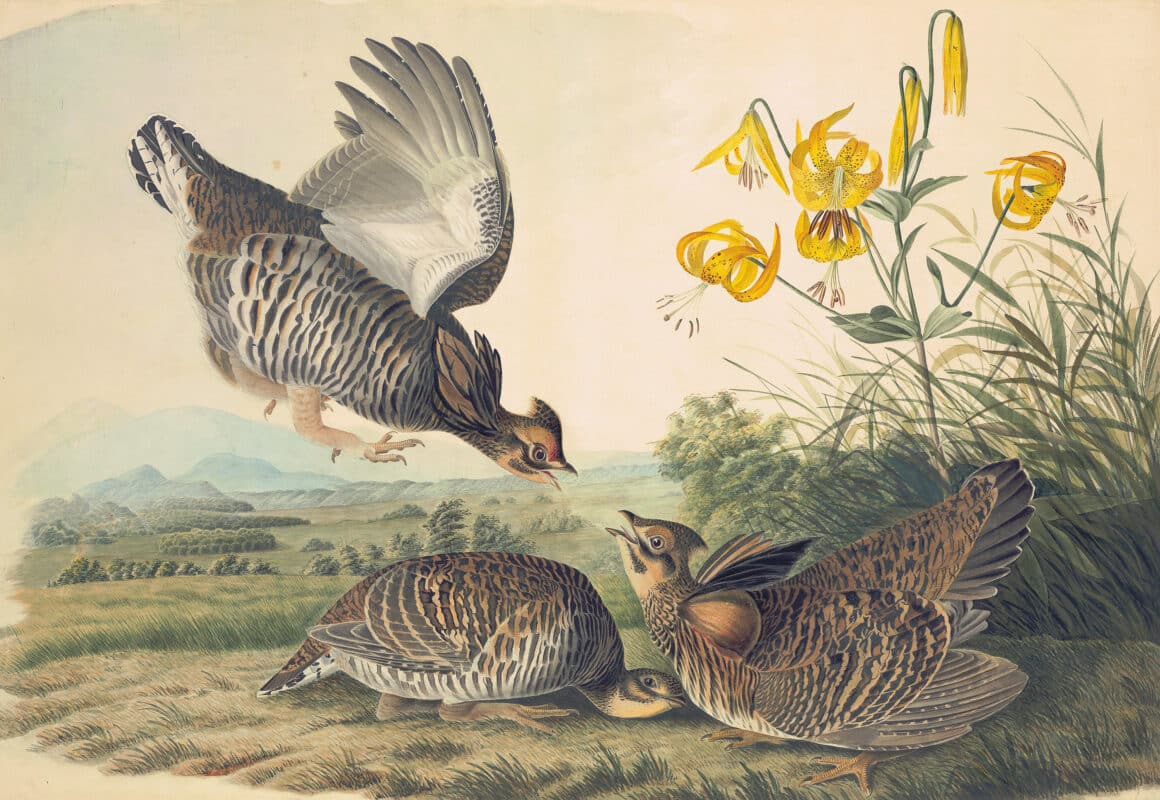
Likewise, Alexander Wilson, when discussing the Pinnated Grouse (Heath Hen), noted that “Grouse, especially full-grown ones, are becoming less frequent. Their numbers are gradually diminishing; and assailed as they are on all sides, almost without cessation, their scarcity may be viewed as foreboding their eventual extermination” (Wilson, American Ornithology, 1810). Unfortunately, Wilson’s astute observation proved correct as the last documented Pinnated Grouse died in 1932.
North America’s only native parrot species, the Carolina parakeet, is here depicted by Audubon. In his characteristic style, Audubon captures a commotion of the parrots as they flock about an entanglement of cocklebur branches, squabbling and squawking as they were wont to do. The birds appear animated as one splays its wings feathers, another raises a sheepish claw in salutation, while a third arches it’s back in an attempt to capture an out-of-reach cocklebur. The image is vibrant, effectively conveying the vivacious character of the birds. However, when viewed in retrospect, the image is layered with a patina of somber ephemerality and exists as one of the few visual forms of the bird’s documentation before its extinction in 1918.
The proximate and ultimate causes of the parakeet’s extinction range from the expected, overhunting and habitat loss due to human expansion in the 19th century, to the unexpected, the species’ general comradery and the introduction of the European honeybee. Hunted for sport and for their vibrant plumage, the parakeet population suffered a severe loss during the 19th and early 20th centuries. Likewise, with the expansion of railroads, cities, and agricultural developments, the parakeet’s natural habitat and resources were threatened. Likewise, the introduction of the European honeybees, which liked to house in the same tree hollows favored by the parakeets, caused the birds to abandon their typical nesting habits. Lastly, the camaraderie amongst the colonies of parakeets themselves positioned them as easy targets for hunters. When a bird was wounded, the accompanying parakeets would swarm around it in sympathy, thus leaving themselves vulnerable to the aggressor.
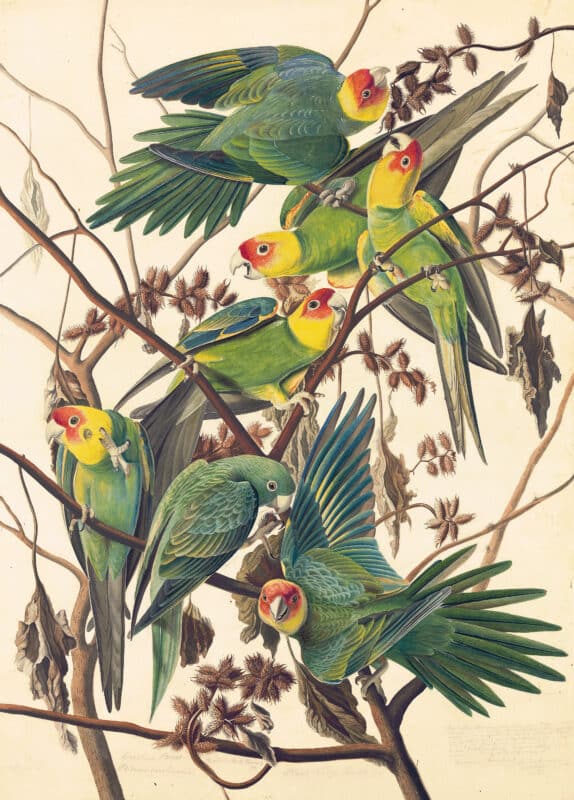
The Labrador (Pied) duck was lost even before the Carolina Parakeet or Pinnated Grouse with the last of the species expiring several decades before the turn of the century. In his print, Audubon renders a male and female of the Labrador (Pied) Duck just moments before the pair takes flight. The forward trajectory of the bird’s bodies suggests that they are moments away from vanishing from the confines of the printed page.

Audubon Havell edition Pl. 322, Labrador (Pied) Duck
In her 2020 essay “Beneath a Wild Sky: Stories of America’s Lost Birds” for an exhibition on the same subject, curator and Audubon expert Linda Miller considers the causality of the Labrador ducks extinction noting that “Besides human predation, expanded settlement on the Atlantic Seaboard may have affected the food sources on which the ducks fed, as increased sewage effluent discharged into coastal shallows reduced shellfish numbers.”
Prior to their decline, there were immense flocks of Eskimo Curlews and Passenger Pigeons in North America with the curlew being one of the most populous shorebirds and the Passenger Pigeon making up 25 to 40 percent of the total bird population. In Audubon’s print of the Eskimo Curlew, the female is – in what has been described as a “prophetic” manner – depicted deceased with the male mournfully looking over her. (The term prophetic was used in reference to this print in a blog titled “Extinct or Endangered Species” by the New York Historical Society).
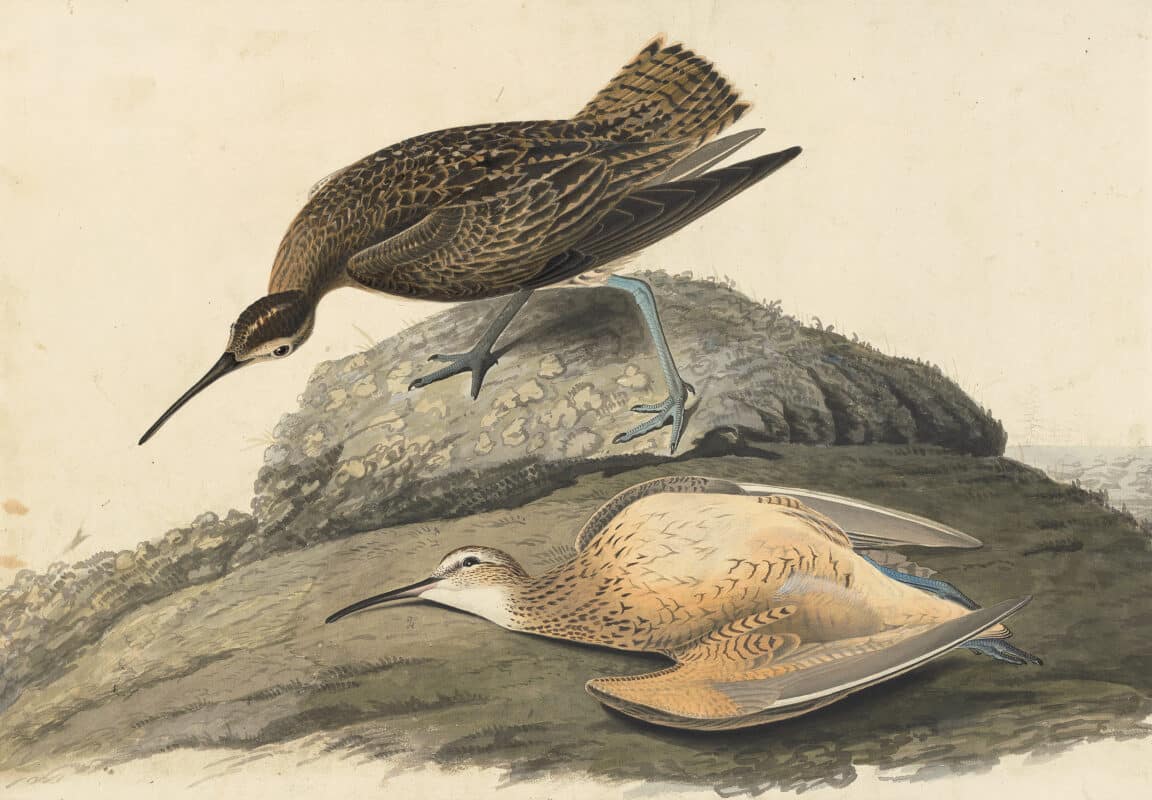
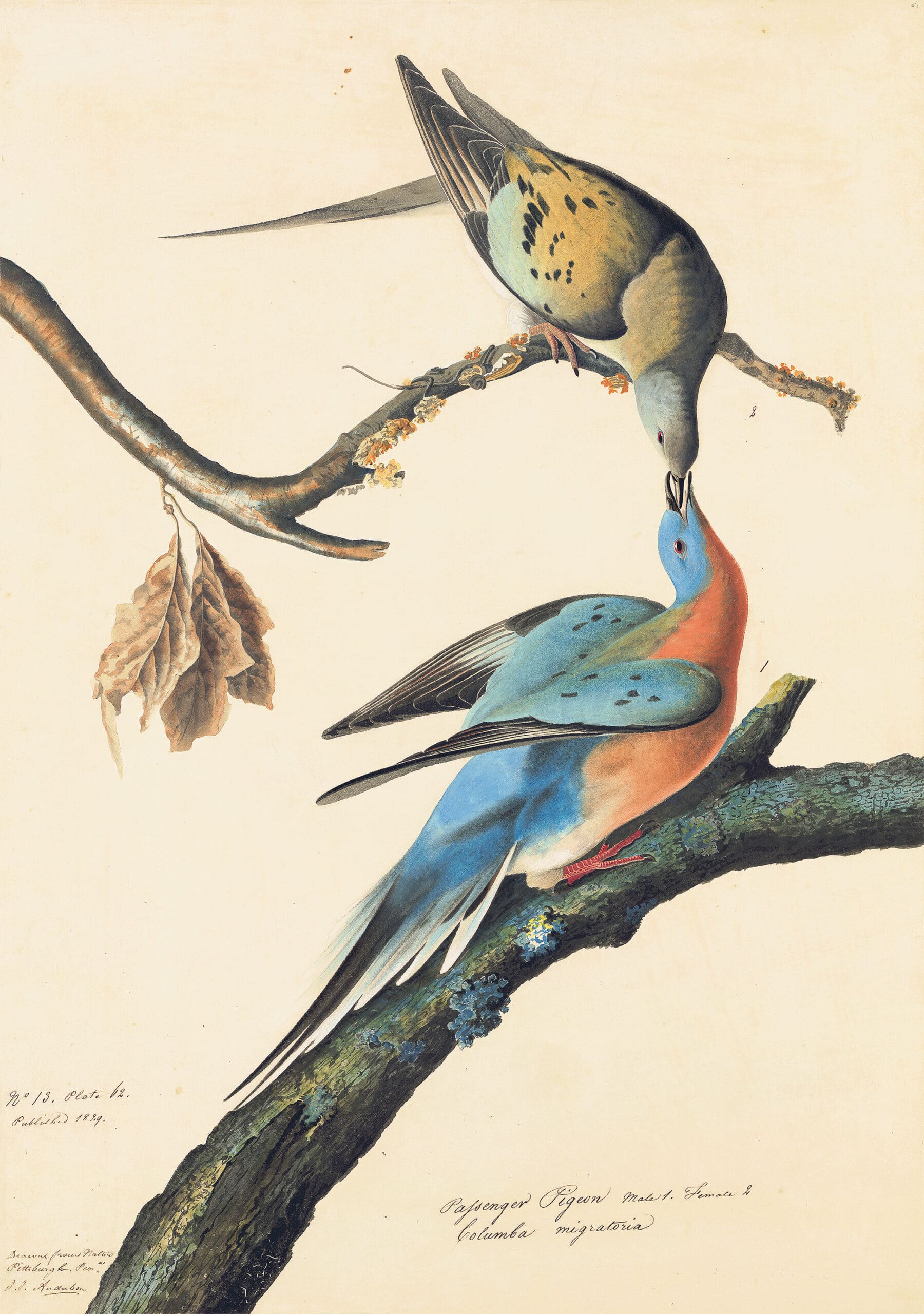
Audubon’s Watercolor Pl 62, Passenger Pigeon
In contrast to Audubon’s foreboding print of the Curlew, his depiction of the Passenger Pigeon is more tender with both birds living and in the midst of sharing an intimate moment where the beak of one meets that of the other. Naturalist Hedwig Pöllöläinen writes that “the formally recognized cause of this species’ extinction was rampant killing by humans, although it would probably have succumbed eventually to the ravages of uncontrolled destruction of the East Coast oak forests to establish farms.” One of the consequences of the loss of the bird is an increase in the proliferation of Lyme disease. As Pöllöläinen explains, “When the passenger pigeons existed in large numbers, they subsisted primarily on acorns. However, since there are no pigeons to eat acorns, the populations of Eastern deer mice — the main reservoir of Lyme disease — exploded far beyond historic levels as they exploited this unexpected food bonanza.” (Audubon’s Aviary: Portraits of Endangered Species, 2008).
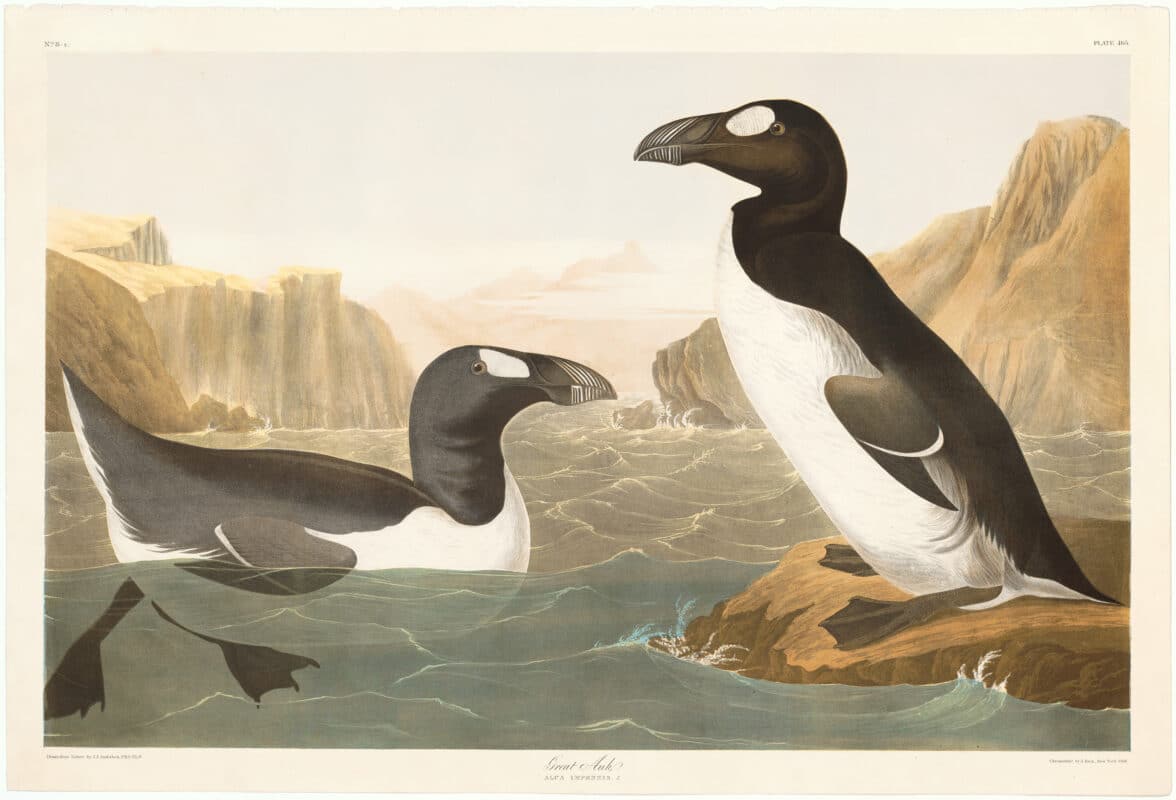
Likewise, the Great Auk was lost to the annals of history as a direct result of human predation. This bird was the last flightless bird native to North America and possess –to its detriment– a friendly demeanor that allowed humans to approach and capture it with little resistance. It has now been extinct since 1844. In fact, Audubon never witnessed the live bird but instead referenced a taxidermized specimen for his rendering.
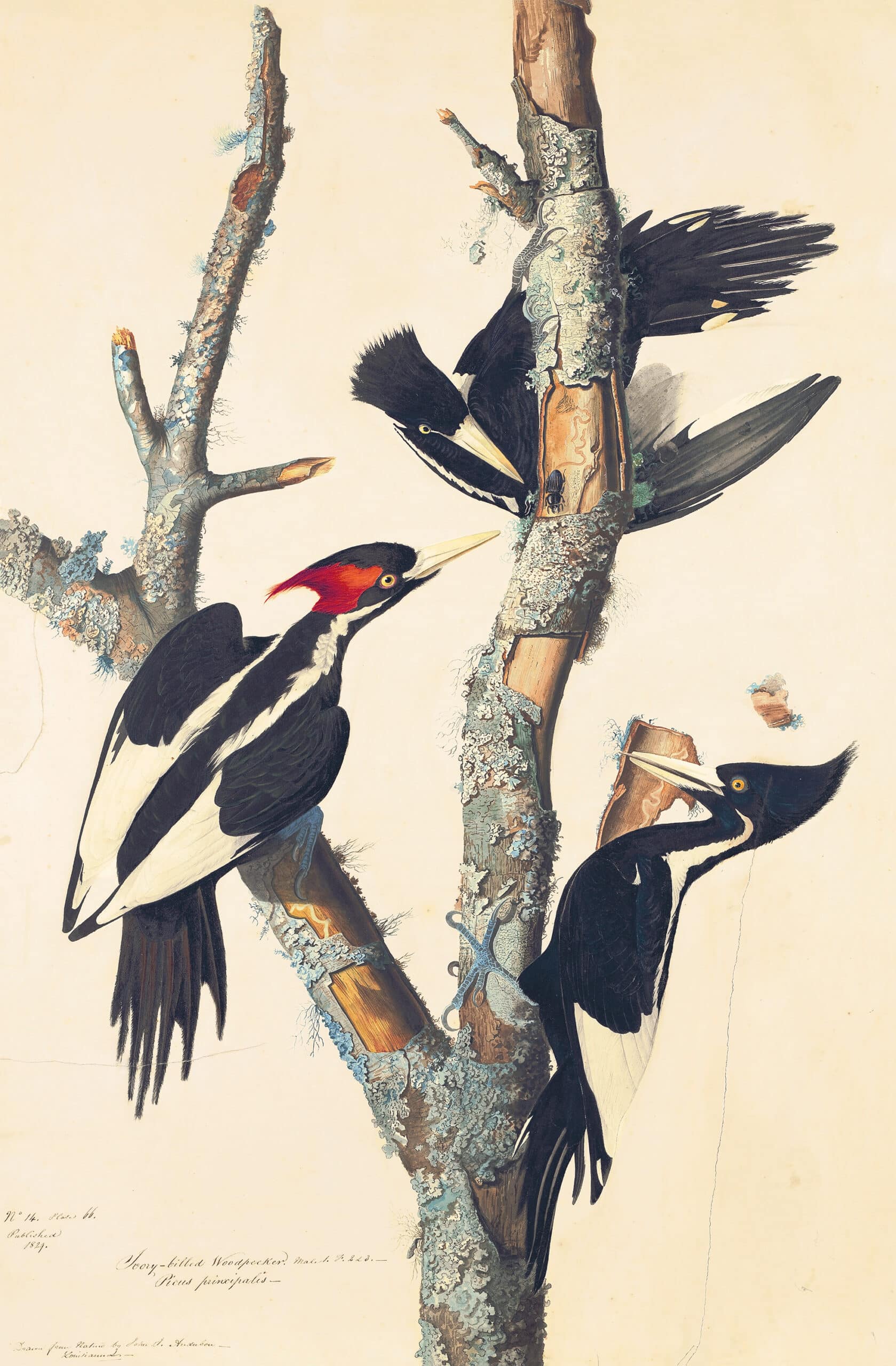
Audubon’s Watercolor Pl. 66, Ivory-billed Woodpecker

Audubon’s Watercolors Pl. 185, Bachman’s Warbler
Similarly, Bachman’s Warbler and the Ivory-billed Woodpecker populations declined as their habitats were destroyed and the birds themselves were hunted for their feathers. The warbler’s feathers were harvested and sold to milliners who used the plumage to decorate women’s hats. Likewise, in Audubon’s era, the woodpecker’s feathers were collected for their aesthetic appeal.
In summary, a sobering number of species have been lost since Audubon’s time by both direct and indirect means. However, through the promulgation of information surrounding the causes and preventative measures relating to species and environmental destruction, a great number of once-endangered species have now been stabilized. For instance, the Californian Condor population, which was once on the brink of extinction, successfully recovered through the efforts of the environmentalists and ornithologists who organized strategic measures to allow the remaining species to recoup undisturbed. Instances such as the case of the condor are encouraging in that they highlight the potential for positive human impact on species recovery.
Audubon’s beautiful renderings of birds coupled with his conservationist approach to the natural world caused him to be the eponymy after which the United States’ first official conservation movement, the Audubon Society, was named. Interestingly, George Bird Grinnell, the founder of the Society, stayed on Audubon’s Manhattan property as a young boy and was taught by Lucy Bakewell Audubon, Audubon’s widow. It is not difficult to imagine that exposure to Audubon’s art played a part in buttressing Grinnell’s appreciation and respect for nature.
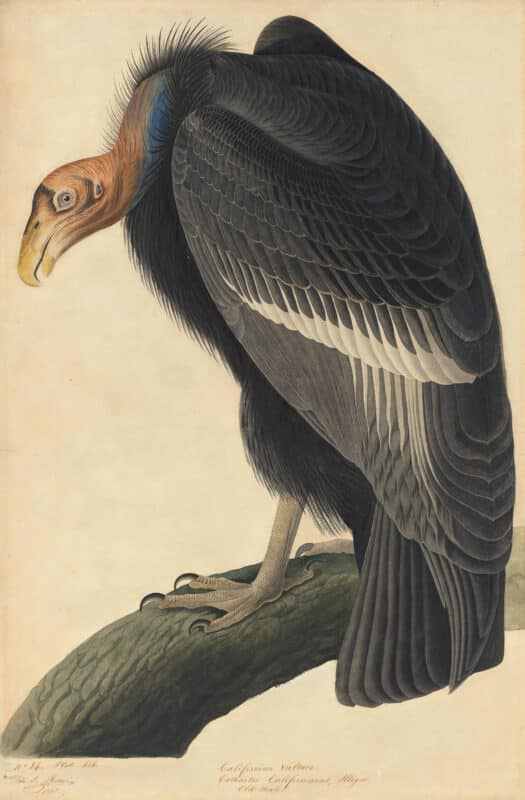

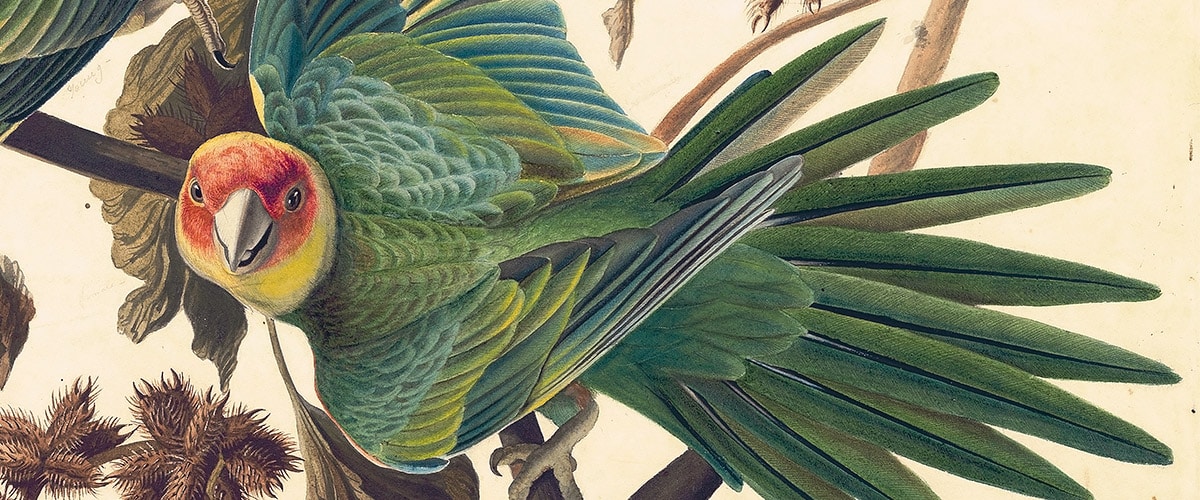
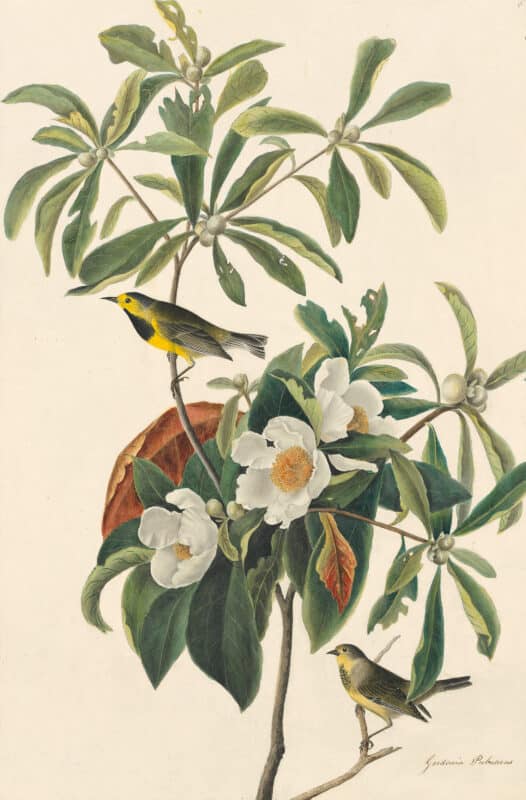

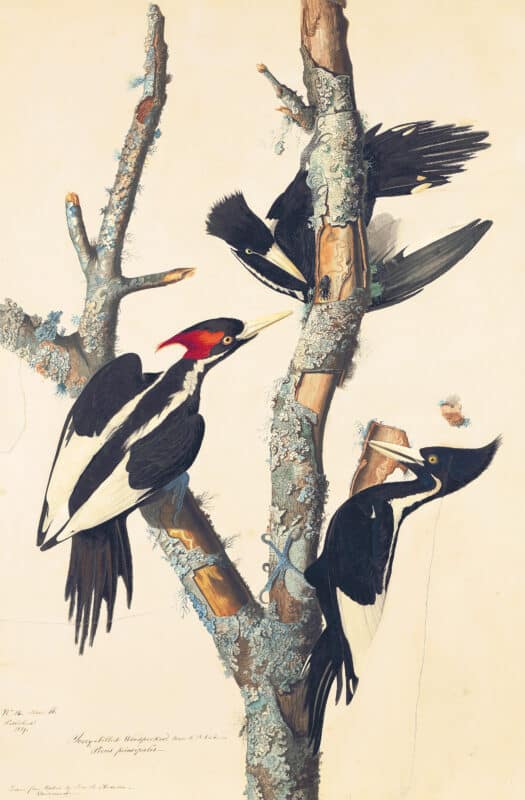
It is so sad to see so many birds extinct since Audubon’s times. I wonder if we should turn our attention from cloning mamoths to trying to clone some of these lovely birds. — facebook.com/GrandpopBubbles/photos.